Iowa does not have much in the way of wild, public land. Most of the state has been developed for agriculture. There are very few parks. But it’s still possible to find some interesting mushrooms in the state[i]. We can’t list all the species, there isn’t room, but we can explore a few of the edible, poisonous, and “magic” species Iowa has to offer.
Most writers have one of two things to say about edible mushrooms—and they’re both wrong.
Some insist that there is a wealth of mushroomy goodness out there, and all you need to do to start enjoying it is read some basic descriptions of a couple of “foolproof” species. Well, there are no foolproof species. The human capacity to mistake one thing for another based on wishful thinking or honest ignorance is infinite. Only experts should be harvesting mushrooms to eat.
But that doesn’t mean foraging is some incredibly dangerous thing only geniuses or foolhardy daredevils (or genius foolhardy daredevils) should attempt. That’s the other thing writers about mushrooms say that isn’t so. Most mushrooms aren’t poisonous, and most that are cause only mild to moderate symptoms most of the time. And with a few important exceptions, most can be identified to species with confidence. And there’s no reason you can’t become an expert yourself.
“Becoming an expert” does not have to mean getting a PhD in mycology. It means being familiar enough with mushrooms that you can not only tell what a mushroom is but what it isn’t. For example, let’s say an exotic mushroom you didn’t even know existed was introduced in your area, and it just happens to closely resemble your favorite edible—one you thought didn’t have a close look-alike. Would you notice the difference? Things like that happen occasionally, after all.
If you do indeed go Mushroom Hunting make sure you have the proper tools, take a quality knife with you and a basket/bag for your haul!
This list is not meant to be used as a replacement for a field guide, spore prints, an identification app or an in person guide.
The point of this article is not to teach you to forage; it’s to give you a reason to learn.
Our Recommended Field Guides
COVER | TITLE | Header | ||
|---|---|---|---|---|
OUR #1 RATED | ||||
Edible Mushrooms in Iowa
Morels (Morchella sp.)


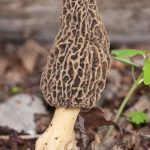

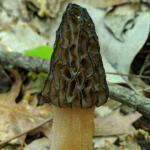

Morels are a group of edible mushrooms so popular that to some foragers, nothing else really counts as a mushroom. Unfortunately, morels do occasionally make people sick, even when cooked correctly. No one knows why. It may be some humans are more sensitive than others, so it’s best to only eat a little your first time.
Another complication is that while it’s relatively easy to tell that something is a morel (there are look-alike false morels, but those are not difficult to distinguish), figuring out which morel you’ve got can be very hard. Some species are very variable or very similar to each other. Iowa has at least three species: the Half-Free (Morchella punctipes), the Gray (Morchella americana), and Eastern Black (Morchella angusticeps).
Inky Caps
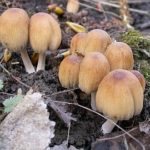

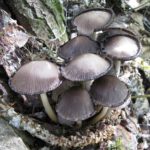

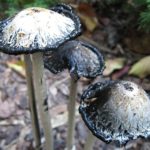

Inky caps used to all belong to the same genus, but, as so often happens with mushrooms, they’re not even all in the same family anymore. Their claim to fame is they turn to black goo as they mature. The trick is to harvest them before they goo and to use them promptly. The goo itself is edible, and makes an interesting food dye, it’s just not really a mushroom anymore. The Mica Cap (Coprinellus micaceus) and the Tippler’s Bane (Coprinopsis atramentaria) both contain a substance that interferes with the metabolism of alcohol; drink something alcoholic within a few days of eating either, and you’ll get sick. Shaggy Mane (Coprinus comatus) does not have that limitation.
Oyster Mushrooms (Pleurotus sp.)
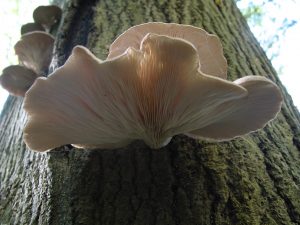



The oyster mushrooms got their name because some of them look a little like oysters. They don’t taste oyster-like, but do taste good. Their texture is quite delicate, so while they are easy to cultivate, they don’t ship well and are rarely sold. Pleurotus ostreatus is the original oyster, the one people mean when they say “oyster mushroom” without specifying which one. The Golden Oyster (Pleurotus citrinopileatus)[ii] also grows in Iowa, but it’s not native to North America. It probably escaped from cultivation and is spreading fast. It’s a lovely lemon-yellow color, and quite tasty, so perhaps the best thing to do is to eat as much as possible of this invasive species
Polypores




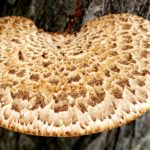

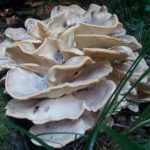

Polypores are another group that used to be clumped together in a single, giant genus, but have since been split up. They all have a pore surface, rather than gills, and all of them attach to their substrate on the side, either directly (like a shelf) or by a short stem (like a frying pan). Some are woody and unpalatable, but there are good edibles in the group.
Chicken-of-the-Woods (Laetiporus sp.) is probably the most famous. These are a closely-related group of species known for their yellow-orange color and, yes, for tasting like chicken. Some chickens are mildly toxic, and some are less palatable, but most are very good. Hen-of-the-woods, or Maitake (Grifola frondosa) has a similar name, but looks very different, rather like a pile of gray feathers. It’s good fried with cheese, like a cheesestake. Dryad’s saddle, or Pheasant Back (Polyporus squamosus)[iii], is very large and impressive-looking, but it’s taste is…not excellent. Black-Staining Polypore (Meripilus sumstinei)[iv] is very tough but has an excellent flavor; it simply requires a cook able to get that flavor out.
Aborting Entoloma
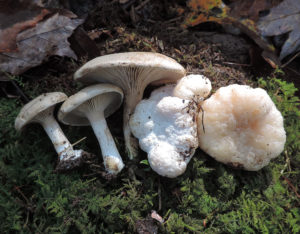

Here’s an interesting story. For years, this mushroom, a twisted-up white thing sometimes called Shrimp-of-the-Woods, was thought to be an Entoloma that had been attacked by a parasitic honey mushroom—after all, the DNA of both were present, and ordinary Entoloma abortivum was often found fruiting normally nearby. Surely those were the ones that escaped?
Nope[v].
The Entoloma is the aggressor. The honey mushroom is the victim. That’s why some people are now calling the result the “abortive” not the “aborted” Entoloma. In any case, it is edible, as is the more typical mushroom produced by the Entoloma in question. However, since some close look-alikes are toxic, many people advise not eating this one unless its honey-mushroom victim is nearby to confirm its ID[vi].
Fairy Ring Mushroom (Marasmius oreades)
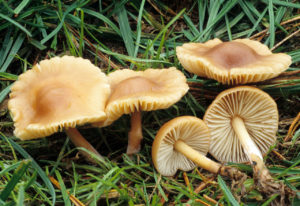

The name “fairy ring” has some interesting stories attached to it, but it’s also likely to cause confusion. This species is one of several fungi that sometimes form rings. What happens is that as the mycelium expands in an ever-widening circle, it runs out of food and dies back in the middle, leaving a ring. Similar rings are produced by the same mechanism by some lichens and even a wide variety of plants. What makes fungal rings especially notable is that the fungus grows underground, un-noticed (except for the darker color of the grass above it) until one morning there is a circle of mushrooms that wasn’t there before. It’s kind of eerie. And so, the legend grew up that the mushrooms showed where fairies had been dancing.
But the problem is that people tend to assume that the ring must be a good field mark for identifying this one particular species, and it just isn’t[vii]. Fairy-ring mushroom doesn’t always grow in rings, and some of the other mushrooms that do are close look-alikes of this one, and toxic. You have to ignore the ring and look for other characteristics.
This fairy ring is edible, though, with a sweet flavor[viii]. It’s recommended to only eat the caps, as the stems are tough.
Tawny Milk Cap (Lactifluus volemus)


Milk caps get their name from the fact that if you slice their gills, liquid oozes out. In some species, the liquid looks a lot like milk. The color and other characteristics of the “milk” is an important characteristic for species identification. Some milk caps are poisonous or otherwise inedible, but some are delicious. Reportedly, the Tawny Milk Cap[ix] falls firmly in the latter category. When fresh, the mushroom has a rather unfortunate odor, but the scent changes dramatically upon cooking.
Our Recommended Field Guides
COVER | TITLE | Header | ||
|---|---|---|---|---|
OUR #1 RATED | ||||
Poisonous Mushrooms in Iowa
The most dangerous of the poisonous mushrooms are wonderfully scary. Want to give yourself the heeby-jeebies? Read up on the deadly galerina. It’s great fun, as long as you’re confident you haven’t eaten one.
Knowing how to recognize poisonous mushroom species is important if you want to forage, but many of these mushrooms are also lovely to look at and are interesting to know about just on general principle.
Here are two important things to bear in mind. First, there is no rule of thumb about which mushrooms are poisonous. Any rule you may hear someone suggest has its exceptions and could lead to you getting sick. There is no shortcut to identifying a mushroom to species. Second, this list is by no means exhaustive—the fact that a mushroom isn’t on this list should not be taken to mean that it’s safe to eat. Again, you just have to look everything up.
Destroying Angel (Amanita bisporigera)
There are several destroying angel species, all of them large, handsome, and white or whitish. All are aptly named—their toxin will kill most eaters. Even those who receive prompt and proper medical care do not always survive. Diagnosis is difficult because the symptoms might not appear for as much as a day, sometimes more. Not everybody associates the illness with yesterday’s mushroom meal.
Although the destroying angel is a very distinctive-looking group of species, it’s not uncommon for inattentive foragers to ignore the distinctive features and mistake this poisonous mushroom for almost any large, white or whitish edible species.
Deadly galerina (Galerina marginata)


Deadly galerina contains the same toxin as the destroying angel (and a few other species) and is just as dangerous. Worse, it’s a little brown mushroom (LBM), meaning it is a nondescript, brownish mushroom just like many other nondescript, brownish species, including several popular edible and “magic” species, some of which share the same habitat. The Deadly Galerina can grow in mixed clumps with its edible and magic look-alikes.
Torn Fibercap (Inocybe rimosa)


The torn fibercap[x] is one of a large group of nearly identical mushrooms that really only experts can sort out. In any case, the whole group is best treated as toxic. Some, including this one, contain a potentially deadly dose of muscarine, a toxin capable of causing a huge number of variable symptoms you really don’t want[xi]. It counts as a “little brown mushroom,” LBM, though it is a very pale brown, and is another reason no LBM should ever be eaten incautiously.
False Morels


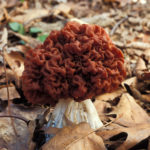

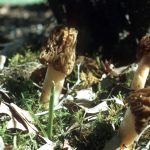

False morels are so called because they look enough like true morels to cause confusion, though the differences between the two groups are pretty clear if you know to look for them. Perhaps most notably, morels have pitted caps, something like honeycomb, whereas false morels have wrinkled caps. The phrase “false morel” is most commonly applied to the genus, Gyromitra. Iowa has at least two species, G. brunnea and G. caroliniana. Sometimes a few members of other genera are also included, such as Verpa bohemica.
People not-infrequently eat false morels and get sick, but these are not usually cases of mistaken identity; some people insist false morels are safe to eat. And it’s true that many people eat them with no apparent ill-effect, provided the mushrooms have been properly cooked in a well-ventilated area. But others get sick, and there’s also some suggestion that their toxins may build up in the body over time.
Flat-Cap Agaric (Agaricus placomyces)
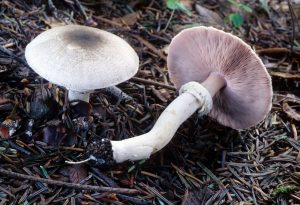

The flat-cap[xii] vaguely resembles several closely-related edible species—proper identification is not difficult, but an inexperienced or inattentive forager could make a mistake. It doesn’t help that “meadow mushroom” is an alternate common name for the flat-top, but also a common name for one of the edible species. One distinctive feature of this species is a tar-like odor. Eating the mushroom causes gastrointestinal problems in most people. Some people can eat it without trouble.
Magic Mushrooms in Iowa
There is an active movement in Iowa to legalize, or at least decriminalize, magic mushrooms, but as of this writing, it has not yet succeeded[xiii]. Use or possession of psilocybin in any form is a violation of both state and Federal law. In addition to legal risk, all psilocybin-containing mushrooms also closely resemble poisonous species, including the Deadly Galerina. Psilocybin use itself is not risk-free, but if certain safety procedures are followed, mushrooms are safer than many other mind-altering substances. Several wild psychoactive mushroom species grow wild in Iowa[xiv].
Rustgills (Gymnopilus sp.)
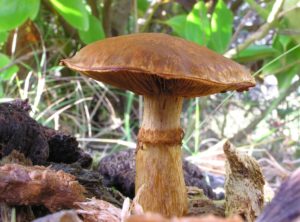

There are a group of very similar, closely-related species that are psychoactive but qualitatively a little different from the Psilocybes. There isn’t a lot of information available on what taking them is like. The taxonomy of the group is a bit muddled. The name “rustgill,” is apt given the orangish spores, but psychonauts usually call them Gyms.
Banded Mottlegill (Panaeolus cinctulus)
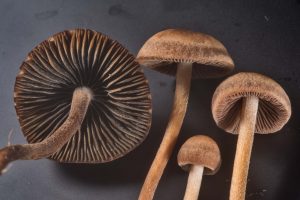

The Mottlegills have their name because their spores mature and darken unevenly, producing a mottled appearance. Some are not psychoactive at all, while others are very potently so. The Banded Mottlegill, so-named because of a pale band around the rim of the cap, is in the middle of the spectrum, slightly below average as psychoactives go. Psychonauts tend to call the group not mottlegills but Pans.
Our Recommended Field Guides
COVER | TITLE | Header | ||
|---|---|---|---|---|
OUR #1 RATED | ||||
References:
[i] (n.d.). Mushroom Foraging in Iowa. Iowa State University Extension and Outreach
[ii] Bergo, A. (n.d.). Foraging Golden Oyster Mushrooms (Pleurotus citrinopileatus). Forager/Chef
[iii] Volk, T. (2001). Tom Volk’s Fungus of the Month for May 2001. Tom’s Fungi
[iv] Bergo, A. (n.d.). The Black-Staining Polypore. Forager/Chef
[v] Kuo, M. (2014). Entoloma abortivun. MushroomExpert
[vi] Bergo, A. (n.d.). Shrimp of the Woods: Aborted Entoloma Mushrooms. Forager/Chef
[vii] Kuo, M. (2013). Marasmius oreades. MushroomExpert
[viii] Wood, M., Stevens, F. (n.d.). California Fungi—Marasmius oreades. The Fungi of California
[ix] Bergo, A. (n.d.). Lactifluus volemus. Forager/Chef
[x] (n.d.). Inocybe rimosa (Bull.) P. Kumm.–Torn Fibercap. First Nature
[xi] George, P., Hegde, N. (2013). Muscarinic Toxicity Among Family Members After Consumption of Mushrooms. Toxicology International 20(1): 113-115.
[xii] (n.d.). Agaricus placomyces.
[xiii] Dubley, P. (2022). Are Psychedelics Legal in Iowa Yet? Tripsitter
[xiv] (n.d.). Which Psilocybin Mushroom Grow Wild in My Area? Shroomery

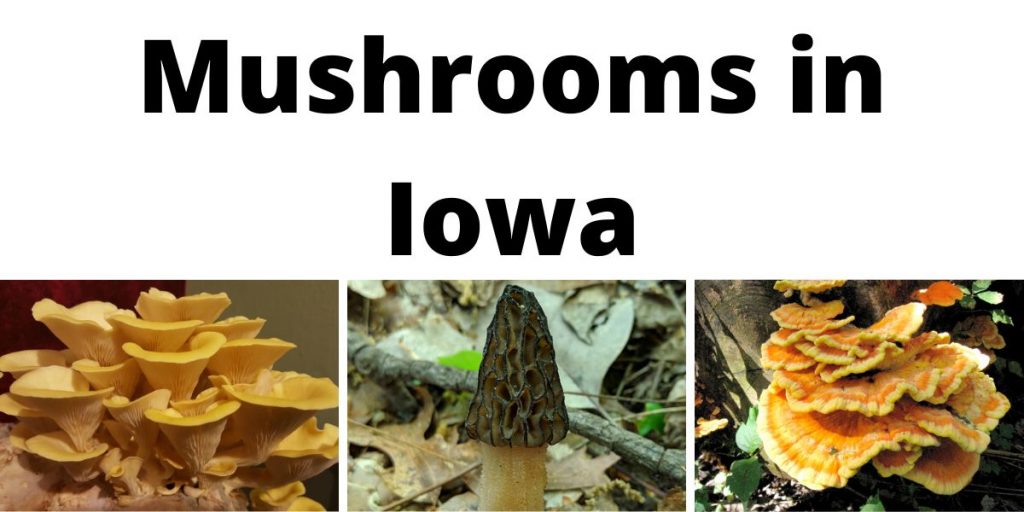
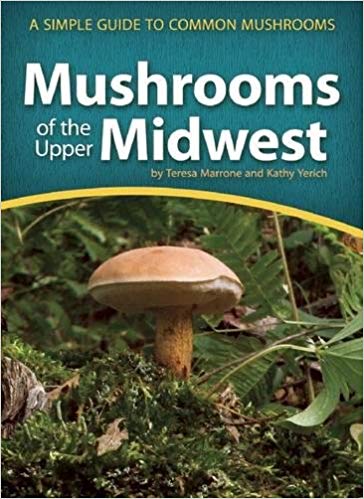
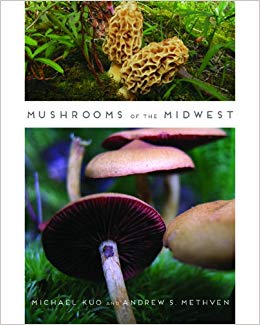


This is writing excellence. I thoroughly enjoyed reading this. Thank you for all the sources; it shows dedication and passion.